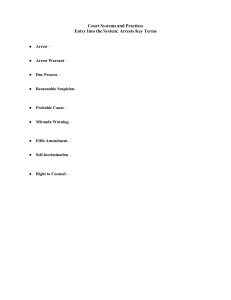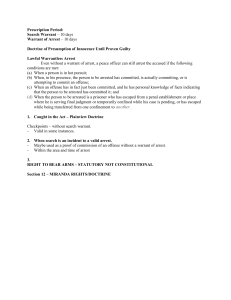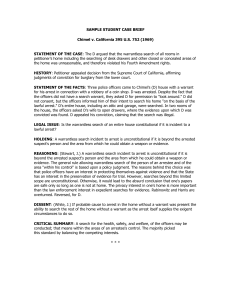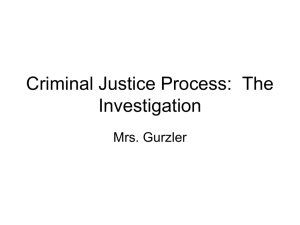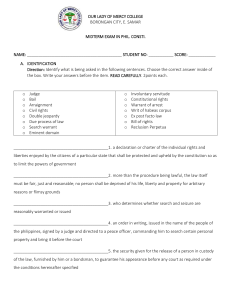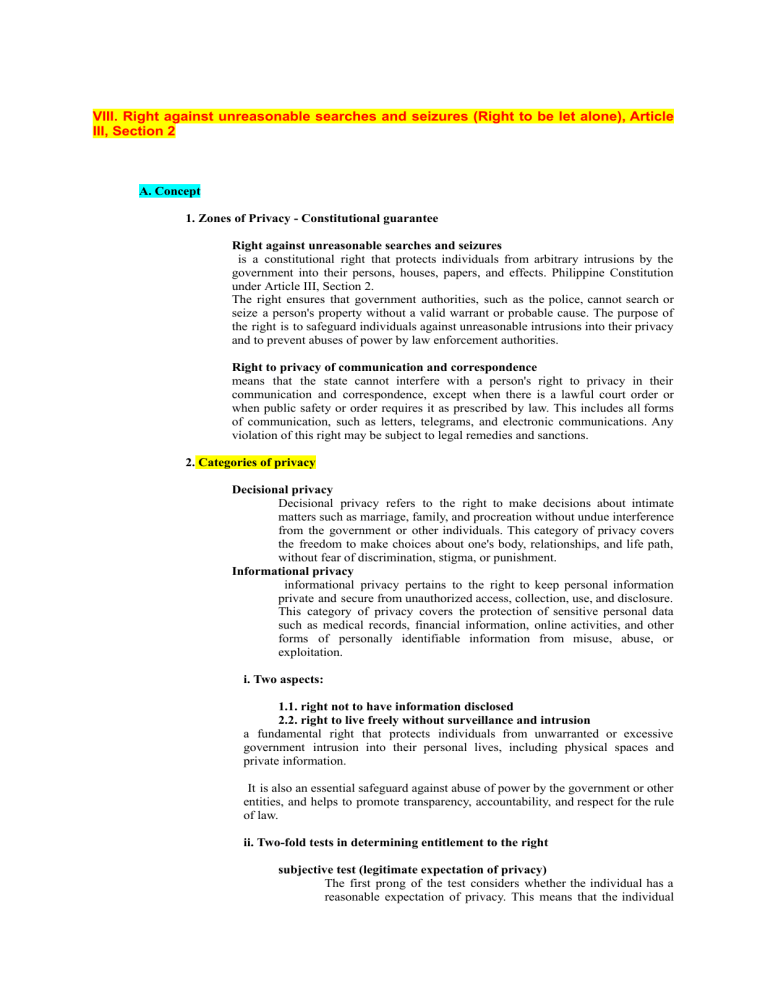
VIII. Right against unreasonable searches and seizures (Right to be let alone), Article III, Section 2 A. Concept 1. Zones of Privacy - Constitutional guarantee Right against unreasonable searches and seizures is a constitutional right that protects individuals from arbitrary intrusions by the government into their persons, houses, papers, and effects. Philippine Constitution under Article III, Section 2. The right ensures that government authorities, such as the police, cannot search or seize a person's property without a valid warrant or probable cause. The purpose of the right is to safeguard individuals against unreasonable intrusions into their privacy and to prevent abuses of power by law enforcement authorities. Right to privacy of communication and correspondence means that the state cannot interfere with a person's right to privacy in their communication and correspondence, except when there is a lawful court order or when public safety or order requires it as prescribed by law. This includes all forms of communication, such as letters, telegrams, and electronic communications. Any violation of this right may be subject to legal remedies and sanctions. 2. Categories of privacy Decisional privacy Decisional privacy refers to the right to make decisions about intimate matters such as marriage, family, and procreation without undue interference from the government or other individuals. This category of privacy covers the freedom to make choices about one's body, relationships, and life path, without fear of discrimination, stigma, or punishment. Informational privacy informational privacy pertains to the right to keep personal information private and secure from unauthorized access, collection, use, and disclosure. This category of privacy covers the protection of sensitive personal data such as medical records, financial information, online activities, and other forms of personally identifiable information from misuse, abuse, or exploitation. i. Two aspects: 1.1. right not to have information disclosed 2.2. right to live freely without surveillance and intrusion a fundamental right that protects individuals from unwarranted or excessive government intrusion into their personal lives, including physical spaces and private information. It is also an essential safeguard against abuse of power by the government or other entities, and helps to promote transparency, accountability, and respect for the rule of law. ii. Two-fold tests in determining entitlement to the right subjective test (legitimate expectation of privacy) The first prong of the test considers whether the individual has a reasonable expectation of privacy. This means that the individual must have taken steps to ensure that their private affairs remain private. For example, if an individual uses a password to protect their personal computer, they have a reasonable expectation of privacy in the files and data stored on their computer. 2.2. objective test (society accepts expectation as reasonable) The second prong of the test considers whether the intrusion into the individual's private affairs is highly offensive to a reasonable person. This means that the intrusion must be evaluated from an objective perspective, taking into account the norms and values of society. For example, if a person is secretly recorded in a private setting without their knowledge or consent, this intrusion into their private affairs would likely be considered highly offensive to a reasonable person. 3. To whom directed The Right against unreasonable searches and seizures is directed towards the government or state authorities, particularly law enforcement agencies, prohibiting them from conducting searches and seizures that are unreasonable or conducted without a warrant or probable cause. The purpose of this right is to protect individuals from arbitrary or abusive government action, and to uphold the fundamental right to privacy. Case: People v Andre Marti, GR 81561, 18 Jan 1991 Who may invoke the right? may be invoked by any person whose rights have been violated by the government or its agents through an unreasonable search or seizure. This includes both individuals and legal entities, such as corporations. However, the person invoking the right must have a reasonable expectation of privacy in the place or object searched or seized. Cases: - Bache and Co. (Phil.) Inc., v Judge Ruiz, GR L-32409, 27 Feb 1971 - Stonehill v Diokno, GR L-19550, 19 Jun 1967 B. Requisites for a valid warrant 1. Probable cause Probable cause is a legal standard used to determine whether a law enforcement officer has sufficient reason to believe that a crime has been committed, and whether there is a need to conduct a search or make an arrest. Or leads a prudent man to believe an offense has been committed. Cases: - Burgos v Chief of Staff, GR L-64261, 26 Dec 26, 1984 - AAA v Carbonell, GR 171465, 8 Jun 2007 - People and Pastrana v Abad, GR 196025, 21 Feb 2018 2. Issued personally by a judge must be signed by the judge and must be based on the judge's personal determination of probable cause. This requirement ensures that the judge independently evaluates the evidence presented by the prosecutor or law enforcement officer to determine if there is sufficient evidence to support the issuance of the warrant. Cases: - Soliven v Judge Makasiar, GR 82585, 14 Nov 1988 - Pita v CA, GR 80806, 5 Oct 1989 3. Examination under oath or affirmation The warrant should be issued by a judge or a court, and the person being examined should be informed of their right to remain silent and to have a counsel present during the examination. The examination is usually conducted to obtain information or evidence that will aid in the investigation or prosecution of a crime. However, any statement obtained through an examination under oath or affirmation must be voluntary and not obtained through coercion or intimidation. Failure to comply with these requirements may render the examination and any evidence obtained inadmissible in court. Cases: - Pasion Vda. De Gracia v Locsin, GR L-45950, 20 Jun 1938 - Mata v Bayona, GR 50720, 26 Mar 1984 4. Particular description of persons, things and places Cases: - Del Castillo v People, GR 185128, 30 Jan 2012 - People v Salanguit, GR 133254-55, 19 Apr 2001 - Dimal and Castillo, v People, GR 216922, 18 Apr 2018 Warrantless arrests, Rules of Court, Rule 113, Section 5 Under Section 5, Rule 113 of the Revised Rules of Criminal Procedure, a peace officer or a private person may, without a warrant, arrest a person: When, in his presence, the person to be arrested has committed, is actually committing, or is attempting to commit an offense; (b) When an offense has in fact just been committed, and he has personal knowledge of facts indicating that the person to be arrested has committed it;and (c) When the person to be arrested is a prisoner who has escaped from a penal establishment or place where he is serving final judgment or temporarily confined while his case is pending, or has escaped while being transferred from one confinement to another 1. in flagranti delicto It refers to a situation where a person is caught in the act of committing a crime, or immediately after the commission of a crime, and is therefore subject to immediate arrest. The principle behind this concept is that a crime is ongoing, and the arrest is necessary to prevent the person from escaping and to preserve evidence. Cases: - People v Sucro, GR 93239, 18 Mar 1991 - People v Go, GR 116001, 14 Mar 2001 - Reyes v People, GR 229380, 6 Jun 2018 - Umil v Ramos, GR 81567, 9 July 1990 (on rebellion- is a continuing offense) - Luz v People, GR 197788, 29 Feb 2012 (penalty of fine, not imprisonment) - Villamor v People, GR 200396, 22 Mar 2017 2. hot pursuit Hot pursuit in warrantless arrest is a doctrine that allows law enforcement officers to make an arrest without a warrant when the suspect is fleeing or in the act of escaping from the scene of a crime. In hot pursuit situations, the officer must have probable cause to believe that the suspect has committed a crime, and the pursuit must be immediate and continuous. The pursuit must also be in the vicinity of the crime scene, and the officer must have reasonable grounds to believe that the suspect is trying to escape or is a threat to public safety. The doctrine is designed to allow law enforcement to quickly apprehend suspects who are in the act of committing a crime or who pose an immediate threat to the public. Cases: - People v Gerente, GR 95847-48, 10 Mar 1993 - People v Cubcubin, GR 136267, 10 Jul 2001 - Time of arrest refers to the period during which the police may lawfully make a warrantless arrest in pursuit of a fleeing suspect. The arrest must be made immediately after the commission of the offense, or after the offender has escaped, and the arresting officers must continue the pursuit without unnecessary delay. The time frame for the hot pursuit may vary depending on the circumstances, but it is generally understood that the pursuit must be continuous and the arrest must be made as soon as possible. Once the suspect has been apprehended, the arresting officers must bring the person to the nearest police station or detention center for booking and detention. Cases: - People v Rodrigueza, GR 95902, 4 Feb 1992 - Go v CA, GR 101837, 11 Feb 1992 - Lack of Urgency If there is no urgency or necessity for the hot pursuit, then the warrantless arrest is not justified. The police must establish that the circumstances of the case required immediate action and that there was no time to secure a warrant. If the police could have obtained a warrant without risking the escape of the suspect, then a warrantless arrest would not be considered valid. Cases: - People v Pasudag, GR 128822, 4 May 2001 - People v Aminnudin, GR 74869, 6 Jul 1988 3. fugitive from justice A fugitive from justice is a person who has fled from one jurisdiction to another to avoid arrest, prosecution, or imprisonment for a crime they have allegedly committed. In the context of warrantless arrests, a peace officer may arrest a fugitive from justice without a warrant if the officer has probable cause to believe that the person being arrested is a fugitive from justice. In this case, the warrantless arrest is allowed because the person is considered a flight risk and their capture is a priority in the interest of justice. The arresting officer must have a reasonable belief that the person is a fugitive from justice based on reliable information, and the person must have been charged with or convicted of a crime in the jurisdiction from which they are fleeing. D. Administrative arrests Administrative arrest refers to the arrest made by law enforcement officers for the purpose of investigating administrative offenses committed in their presence or in cases where there is probable cause that an administrative offense has been committed. Unlike criminal offenses, administrative offenses are violations of regulations and rules established by administrative agencies, and the penalties imposed for such offenses are typically less severe than those imposed for criminal offenses. Administrative arrests are usually made to maintain order and discipline in the workplace or in public offices, such as in cases of violation of traffic rules, illegal vending, and other minor offenses. The procedure for administrative arrests may differ from that of criminal arrests, but the arresting officer is still required to inform the person being arrested of the reasons for the arrest and the charges against him or her. Warrantless searches 1. Consent or waiver Consent refers to the voluntary and intelligent yielding of a right or privilege. In the context of warrantless searches, it means that the person subject to the search has given their consent or permission for the search to take place. The consent must be given freely and voluntarily, without any coercion or intimidation from the authorities. If the consent is given freely and voluntarily, the search will be considered legal. On the other hand, waiver refers to the intentional relinquishment or abandonment of a known right or privilege. In the context of warrantless searches, it means that the person subject to the search has waived their right to privacy and has given up their right to object to the search. For example, if a person voluntarily goes to a police station and allows themselves to be searched, they are waiving their right to privacy and are consenting to the search. Both consent and waiver are considered exceptions to the rule that a warrant is required for searches and seizures Cases: - People v Omaweng, GR 99050, 7 Sep 1992 - Veroy v Layague, GR L-95630, 18 Jun 1992 - People v Damaso, GR 93516, 12 Aug 1992 2. Search incident to lawful arrest It refers to a search conducted by a police officer of the person of an individual and the area within the immediate control of the person at the time of the arrest. The purpose of the search is to ensure the safety of the arresting officer and to prevent the destruction of evidence. a search incident to lawful arrest is considered a valid warrantless search if it meets the following requirements: The arrest must be lawful; The search must be contemporaneous with the arrest; The search must be made only on the person of the one arrested and the immediate vicinity; The purpose of the search is to ensure the safety of the arresting officer and to prevent the destruction of evidence; The search must be conducted in a lawful manner, without violence or unnecessary rigor; The person being arrested must be within the immediate control of the arresting officer; and The search must be made with the knowledge and consent of the person being arrested, or if without his consent, the search is incidental to the arrest and is justified by the need to protect the arresting officer or to prevent the destruction of evidence. It is important to note that the scope of the search must be limited to the area within the immediate control of the person being arrested, which includes the person's body and the area within his reach or where he could obtain weapons or destroy evidence. The search must not extend to areas beyond the immediate control of the person, such as a nearby room or a container not within reach. Cases: - People v Kalubiran, GR 84079, 6 May 1991 - Espano v CA, GR 120431, 1 Apr 1998 - People v Tangliben, GR L-63630, 6 Apr 1990 - Picardal v People, GR 235749, 19 Jun 2019 3. Moving vehicle The Supreme Court of the Philippines has held that a moving vehicle may be searched without a warrant if there is probable cause to believe that the vehicle contains contraband or evidence of a crime. The search must be limited to the area where the contraband or evidence may be found, and the search must be conducted promptly and in a manner that minimizes the intrusion on the privacy of the occupants. If the search is conducted in violation of these principles, any evidence found may be suppressed in court as inadmissible. Highly regulated by the government, the vehicle’s inherent mobility reduces expectation of privacy especially when its transit in public thorough fares furnishes a highly reasonable suspicion amounting to probable cause that the occupant committed a criminal activity Vehicle: Can be cab, boat, etc, as long as its capable of moving. Routine expection Extensive search Cases: - People v Mago, GR L-27360, 28 Feb 1968 - Asuncion v CA, GR 125959, 1 Feb 1999 4.Emergency circumstances Emergency circumstances refer to situations where there is an imminent danger to life or limb or a threat to national security or public safety, which requires immediate action even without a warrant. In such situations, law enforcement officers may conduct warrantless searches or seizures as long as they have reasonable belief or probable cause that such action is necessary to prevent or stop the danger or threat. Examples of emergency circumstances include the following: Hot pursuit of a fleeing suspect Imminent destruction of evidence Imminent danger to life or limb Need to prevent the escape of a suspect who has just been lawfully arrested In such situations, law enforcement officers may conduct warrantless searches or seizures as long as they have reasonable belief or probable cause that such action is necessary to prevent or stop the danger or threat. However, the scope of the search or seizure must still be reasonable and limited to what is necessary to address the emergency. Case: People v Degracia, GR 102009, 6 Jul 1994 G. Incidents that may lead to warrantless search 1. plain view legal principle that allows law enforcement officers to seize evidence that is in plain view or readily visible during a lawful search or investigation, without a warrant or probable cause. Under this doctrine, if a police officer is legally present in an area and sees evidence of a crime in plain view, they may seize the evidence and use it as evidence in court. However, the plain view doctrine does not allow officers to move objects to get a better view or search beyond the scope of the original search warrant. (a) a prior valid intrusion based on the valid warrant-less arrest in which the police are legally present in the pursuit of their official duties; (b) the evidence was inadvertently discovered by the police who have the right to be where they are; (c) the evidence must be immediately apparent; and, (d) "plain view" justified mere seizure of evidence without further search Cases: - People v Musa, GR 96177, 27 Jan 1993 - Padilla v CA, GR 121917, 12 Mar 1997 - People v Pasudag, GR 128822, 4May 2000 - People v Valdez, GR 129296, 25 Sep 2000 - People v Compacion, GR 124442, 20 Jul 2001 2. checkpoint (visual search vs extensive search) In a checkpoint, a visual search is a limited search where the police officer only visually inspects the vehicle and its occupants to determine if there is any apparent contraband or suspicious activity. The visual search does not involve physical touching or manipulation of the vehicle or the occupants' belongings. On the other hand, an extensive search in a checkpoint goes beyond a visual inspection and includes a thorough inspection of the vehicle and its occupants, including their belongings. This may involve a pat-down search of the occupants and an inspection of the vehicle's compartments, such as the trunk and glove compartment. Generally, a visual search is considered less intrusive than an extensive search and may not require probable cause or reasonable suspicion, while an extensive search may require a higher level of justification. However, the specific rules and requirements for searches in checkpoints may vary depending on the circumstances and the jurisdiction. Cases: - Caballes v CA, GR 136292, 15 Jan 2002 - People v Libnnao, GR 136860, 20 Jan 2003 Checkpoint notes 3. stop and frisk Frisking is to protect himself and to prevent commission of offense Cases: - Terry v Ohio, 392 US 1, (1968) - Posadas v CA, GR 89139, 2 Aug 1990 - Manalili v CA, GR 113447, 9 Oct 1997 - People v Solayao, GR 119220, 20 Sep 1996 - People v Comprado, GR 213325, 4 Apr 2018 (waiver of illegal arrest, not waiver of illegal search and seizure) Order: Stop - reasonable grounds of suspect Frisk- protect from harm Seize - in plain view Arrest - in flagrante delicto Search - incidental of lawful arrest Examples Drive car, habol ka, nakita niya marihuan sa dash board, valid? Yes plain view // in flagrante delicto Question it before arraignment: File motion to quash the warrant (1st), file motion for re-investigation (2nd) Even after arraignment you can still question the search and seizure. Once the object of the warrant is searched, all succeeding search is stopped. (if time is not in the essence then apply for warrant kasi sayang di magiging valid) H. Reasonable searches 1. airports 2, seaports 3. public land transportation terminals, 4. shopping malls, hotels, resorts and other public places Cases: - People v Johnson, GR 138881, 18 Dec 2000 (airport) - Libo-on Dela Cruz v People, GR 209387, 11 Jan 2016 (seaport) - People v Breis, GR 205823, 17 Aug 2015 (bus) - Saluday v People, GR 215305, 3 Apr 2018 (bus terminal) I. Drug, alcohol and blood tests Cases: - Social Justice Society v Dangerous Drugs Board, GR157870, 3 Non 2008 - Lucas v Lucas, GR 190710, 6 Jun 2011 - Jaime Dela Cruz v People, GR 200748, 23 Jul 2014 (Extortion) J. Exclusionary rule 1. RA 9165 (Comprehensive Dangerous Drugs Act) Case: People v Dumagoy, GR 216753, 7 Feb 018 (buy-bust operation) 2. RA 10640 (Amending RA 9165) - Chain of Custody: Requirements; Effects; Sec 21, RA 9165 Cases: - People v Garry dela Cruz, GR 205821, 1 Oct 2014 - People v Gayoso, GR 206590, 27 Mar 2017 - People v Villanueva, 13 Mar 2017 - Dabon v. People, GR 208775, 22 Jan 2018 - People v Crispo, GR 230065, 14 Mar 2018 - People v Que, GR 212994, 31 Jan 2018 - People v Sipin, GR 224290, 11 Jun 2018 - People v Teng Moner y Adam, 5 Mar 2018 (Chain of Custody of Evidence)
